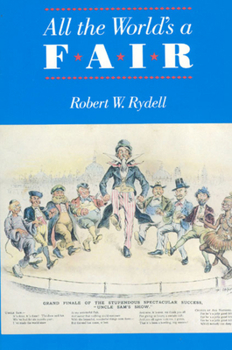All the World's a Fair: Visions of Empire at American International Expositions, 1876-1916
Select Format
Select Condition 
Book Overview
Robert W. Rydell contends that America's early world's fairs actually served to legitimate racial exploitation at home and the creation of an empire abroad. He looks in particular to the "ethnological" displays of nonwhites--set up by showmen but endorsed by prominent anthropologists--which lent scientific credibility to popular racial attitudes and helped build public support for domestic and foreign policies. Rydell's lively and thought-provoking study draws on archival records, newspaper and magazine articles, guidebooks, popular novels, and oral histories.
Format:Paperback
Language:English
ISBN:0226732401
ISBN13:9780226732404
Release Date:October 1987
Publisher:University of Chicago Press
Length:328 Pages
Weight:1.16 lbs.
Dimensions:1.0" x 6.0" x 9.1"
Customer Reviews
2 ratings
World's Fairs and the Leisure Class
Published by Thriftbooks.com User , 23 years ago
Robert W. Rydell's book, All the World's a Fair: Visions of Empire at American International Expositions, 1876-1916 is far different a study than Roy Rosenzweig's, yet it offers some interesting insights into how the moneyed leisure class still indulged in luxuries of their own. Rydell writes that the impetus behind world's fairs was to boost the economy while maintaining an American authority over the displays. Just as saloons and amusement parks were necessary for America's working class, the World's Fairs were designed for the leisure class.The world fairs of 1876-1916 betrayed a much more sinister agenda. Ideas of American progressed became related to scientific racism. The widening concern over immigration by the leisure class eventually promoted eugenicist ideas about the hierarchy of white populations. World's fairs did not stand in direct opposition to the leisure pastimes of the working class. In fact, they utilized them to "scientifically" and racially segregate members of the American population.Rydell argues that the world's fairs in America from 1876-1916 were a material vision of political, business, and intellectuals to promote their vision of racial dominance. Thus, so far we have witnessed segregation of leisure along class lines but not until reading , All the World's a Fair: Visions of Empire at American International Expositions, 1876-1916 is it so clear that the elements of leisure rested on racial superiority.
Great historical study
Published by Thriftbooks.com User , 26 years ago
This book is an extensive study of American World's Fairs from 1876 to 1915, a pivotal period in this country's history. The author gives a lot of historical background about that era, plus a lot of well-researched information about the expositions of that period. He does a great job of showing how these expositions were designed to lure the public into supporting the interests of the power structure of the time. In addition to the text, there are a lot of photographs, some quite rare, to give the reader a feel for these expositions.






